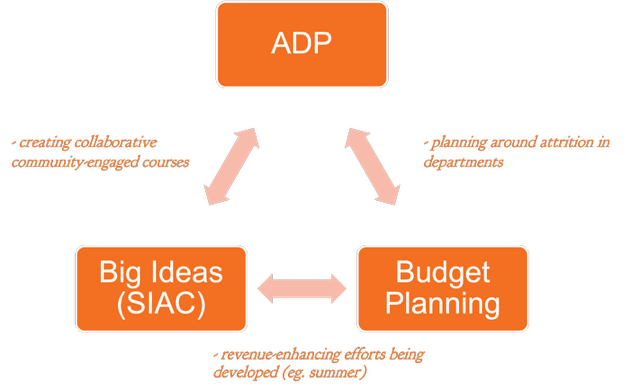Annual Departmental Planning (ADP)

We’ve articulated the primary goal as one of building departmental capacities for making change, and I return again and again to the ‘three-legged stool’ because those three interdependent elements depicted in the image here - curriculum, budget, and workload - are what we’re trying to better balance through this ADP work.
I also stress a related goal of this process: ADP aims to get departments and programs working more collaboratively with standardized data, in a way that encourages ‘local’ solutions within a common framework.
This page contains materials and information related to ADP. If you have questions, please contact Bruce Suttmeier (casdean@), Scott Feickert (sfeickert@), or members of the faculty steering committee for more information.
ADP FAQ
The annual process can be viewed in the image below. This includes a data summit in January, events throughout the semester, including an open forum in March and a departmental happy hour in April, then a day-long workshop in mid-May (after graduation). This work is designed to inform the building of departmental schedules that normally happens in late September.

In practice, especially during this first year as we get used to ADP, the general goals include (a) reducing reliance on visitors and adjuncts; (b) better absorbing leaves, overseas assignments, and retirements; (c) reducing the number of under-enrolled (<10) classes; and (d) increasing opportunities for cross-disciplinary collaboration, with departments and programs either ‘lending’ or ‘borrowing’ teaching capacity.
Different departments will use the data differently. Our goal was to provide data that was meaningful, useable, and relevant to the planning work we need to do in ADP. Needless to say, none of the data metrics capture the totality of our work. None of these metrics will algorithmically determine what a department should do. But taken together, they allow a department to see itself and its work in relation to (and as part of) the larger academic collective. This view across the College is important and one of the goals we had in putting the process together. The best way for a department to familiarize itself with the data (and learn to use it in planning) is to have Bruce or Scott visit a department meeting to speak to the particulars of your department’s or program’s data.
You have to turn in a completed “qualitative response sheet.” The steps are:
- complete the response sheet (either the excel file or word doc).
- rename the file as “Dept.ADP.Apr4” (eg. ENG.ADP.Apr4 or SOAN.ADP.Apr4 or POLS.ADP.Apr4)
- Drop in this google folder (link also available on the ADP data sheet and in all reminder emails).
As depicted in the image below, ADP’s role among these different planning processes can be characterized as operational planning, using widely-accessible data and creating a common framework for individual and collaborating departments and programs to make changes. Big Ideas (SAIC) is the 3-school institutional strategy platform, one that is building a set of imperatives to guide fundraising and enrollment efforts for the next several years. It’s upon the Big Ideas scaffolding that ADP will build out the curriculum for our students. Similarly, with our work on the budget, in the next couple of years, as we have to absorb attrition, retirements, etc. more than we have in the past, the ADP process will be the mechanism for departments to build collaborations, consolidate courses, and/or devise other strategies to accommodate reduced FTE. It’s not new that departments have often had to find creative ways to deal with such situations. What’s new with ADP is an opportunity to have standardized data to make visible such situations; and an opportunity to collaborate and collectively strategize for good curricular solutions.

Office of the Dean of the College is located in room 201 of Albany on the Undergraduate Campus.
MSC: 47
email casdean@lclark.edu
voice 503-768-7100
Dean Bruce Suttmeier
Office of the Dean of the College
Lewis & Clark
615 S. Palatine Hill Road
Portland OR 97219
